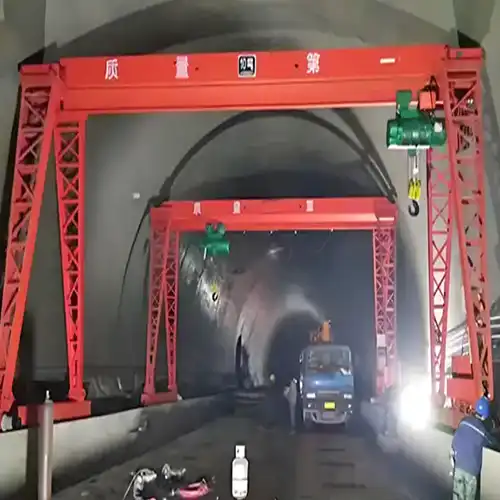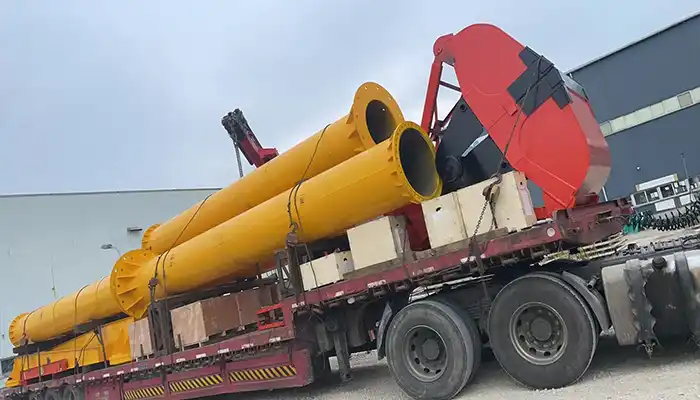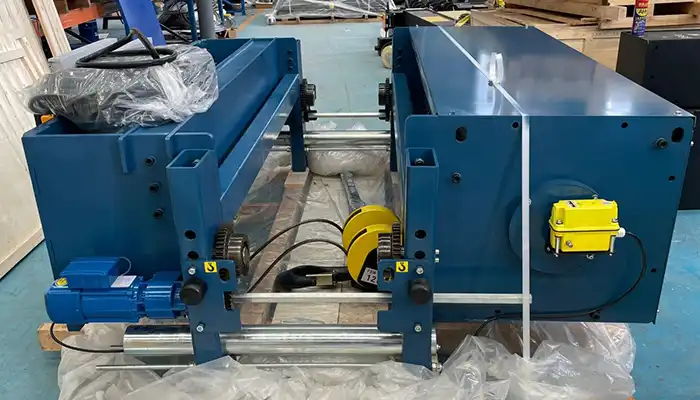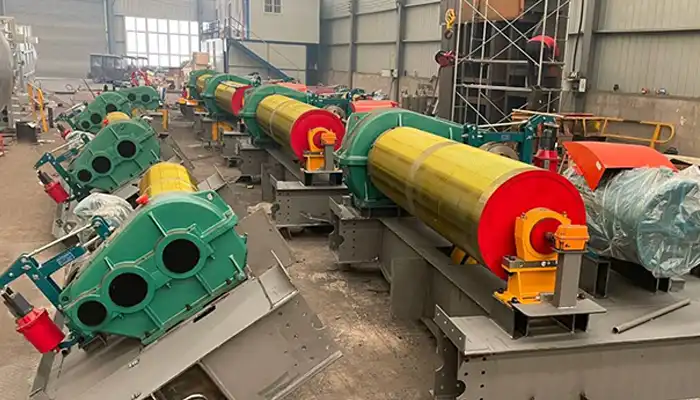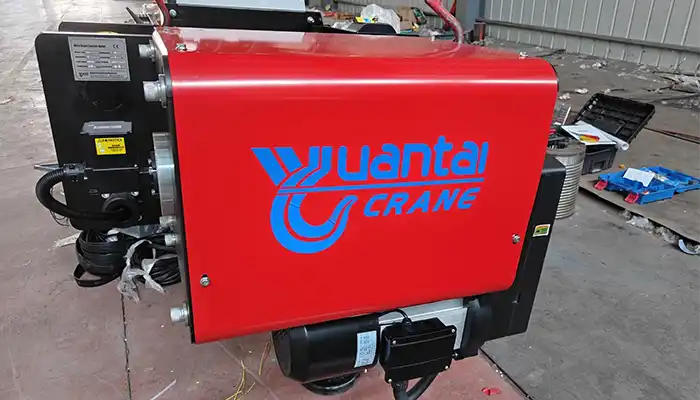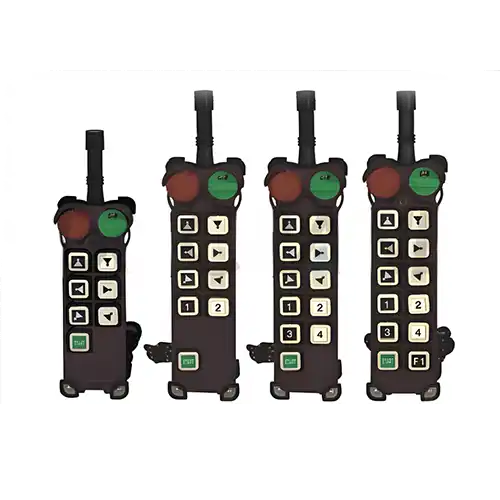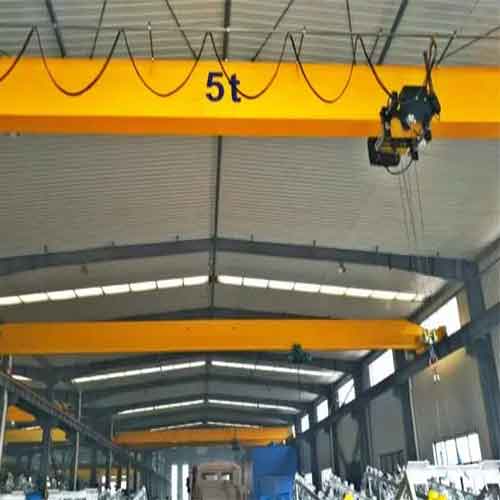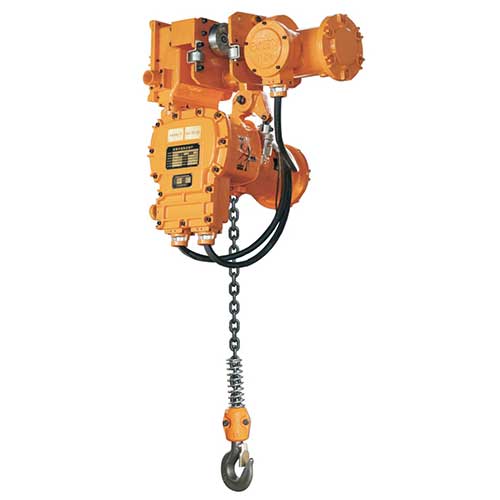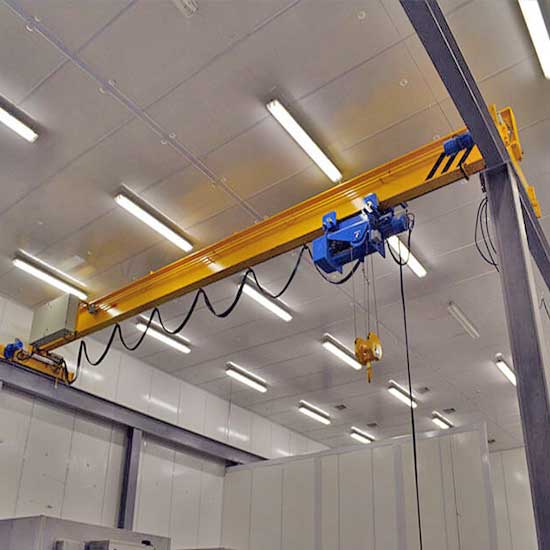Explosion-Proof Gantry Cranes for Safe Coal Mining
Enhance safety and efficiency in coal mining with explosion-proof gantry cranes equipped with grab buckets for reliable material handling.
Category: Hazardous Environment Cranes
Your Trusted Overhead Crane Manufacturer & Supplier
Explosion-Proof Gantry Cranes for Safe Coal Mining
Explosion-Proof Gantry Cranes with Grab Buckets for the Coal Mining Industry
Overview of the Coal Mining Industry
Coal mining is essential for producing energy, but it comes with significant safety challenges. Coal mines are hazardous places where dust, gases, and flammable materials are common. To minimize these risks, coal mining operations need equipment that can handle large volumes of material safely and efficiently. Moving coal—whether from extraction sites to storage areas or to processing plants—requires the use of specialized machines that meet the industry's safety standards.

Importance of Safe and Efficient Material Handling
In coal mining, material handling is key to ensuring the safe transport of coal and ore. This involves moving large quantities of coal while managing risks like:
- Explosive gases (e.g., methane)
- Coal dust which can be highly flammable
- Flammable materials
Explosion-proof gantry cranes are designed to handle these risks by preventing ignition sources, such as sparks, from triggering explosions. These cranes not only protect workers but also help maintain the flow of operations, reducing accidents and downtime.
The Role of Specialized Equipment
Specialized equipment, such as explosion-proof gantry cranes, is critical for coal mining operations. These cranes are designed to work in dangerous environments where the risk of explosion is high. Their explosion-proof features include:
- Flameproof enclosures to prevent sparks
- Sealed electrical systems to avoid overheating
- Dust-tight components to prevent dust buildup
By using these advanced cranes, coal mines can increase safety, reduce risks, and ensure that the mining process runs smoothly. This improves efficiency, reduces labor costs, and enhances productivity.
Explosion-Proof Gantry Cranes
Significance of Explosion-Proof Design
Explosion-proof gantry cranes for coal mining are built to safely operate in hazardous environments where flammable gases or dust may be present. In coal mining, even a small spark can cause an explosion due to the highly combustible nature of coal dust.
Key features of explosion-proof design include:
- Flameproof materials to prevent ignition
- Dust-tight seals to reduce the risk of combustible dust accumulation
- Sealed electrical systems to avoid overheating and sparks
These features ensure that the crane operates safely, reducing the chance of triggering an explosion while handling coal or other hazardous materials.

explosion proof gantry crane with hook

explosion proof gantry crane with grab bucket
Integration of Grab Bucket Systems
Grab bucket systems are often used in conjunction with explosion-proof gantry cranes. These systems help with the efficient and safe handling of bulk coal. The grab bucket is designed to scoop up large amounts of coal, transport it, and unload it with precision.
Types of Grab Buckets:
- Clamshell grabs for handling large amounts of coal
- Double-rope grabs for precise handling in tight spaces
These grab bucket systems provide better control and speed when moving coal from one area to another. By integrating grab buckets with explosion-proof cranes, coal mining operations can enhance both safety and productivity.
The combination of explosion-proof gantry cranes and grab bucket systems ensures that coal is transported efficiently and safely, even in the most hazardous mining environments.
Explosion-Proof Gantry Cranes in Coal Mining
Understanding Explosion-Proof Standards
Industry Standards:
Explosion-proof equipment must meet stringent global and regional standards to ensure safety in explosive environments. Two key standards for explosion-proof cranes are:
- ATEX (Europe): The ATEX directive defines the requirements for equipment used in explosive atmospheres within the European Union. It ensures that machinery can operate safely in environments where flammable gases, vapors, or dust may be present.
- IECEx (International): This is the international standard for explosion-proof equipment. It establishes safety guidelines for manufacturers and provides certification for products that can safely operate in hazardous environments worldwide.
Both standards focus on minimizing the risk of ignition in environments with explosive gases or combustible dust, such as coal mines. Meeting these standards ensures that explosion-proof gantry cranes can operate without causing sparks or heat that could lead to an explosion.
Design Considerations:
The design of explosion-proof gantry cranes is critical to preventing ignition sources in hazardous environments. Some key design features include:
- Flameproof Enclosures: These enclosures prevent sparks or heat from escaping electrical components or motors and igniting the surrounding flammable atmosphere.
- Anti-Static Features: Cranes are equipped with anti-static systems to prevent the buildup of static electricity, which can trigger an explosion in coal mines.
- Explosion Venting Systems: These systems are built into the crane's structure to safely direct any explosion pressure away from sensitive areas, preventing damage or injury.
- Specialized Seals: Seals are used to protect against dust ingress, ensuring that no combustible dust enters electrical or mechanical components that could cause a fire or explosion.
These design features work together to provide a safe operating environment, ensuring that the crane can perform efficiently without compromising safety in explosive atmospheres.
Safety Features and Regulations
Certifications and Compliance:
Explosion-proof gantry cranes used in coal mining must comply with strict safety certifications to operate in hazardous environments. Two major certifications are:
- IECEx Certification: This certification ensures that the crane has passed rigorous safety tests for use in explosive atmospheres. It is recognized internationally and ensures that the crane can operate safely in locations where flammable gases or dust are present.
- ATEX Certification: ATEX compliance is required for equipment used in coal mines within the EU. It involves testing the equipment to ensure it does not cause sparks or ignition in explosive environments.
These certifications guarantee that the crane's design, materials, and operation methods meet the highest safety standards. Regular inspections and tests are required to maintain certification and ensure that cranes continue to meet these rigorous safety criteria.
Protection Against Combustible Dust and Gases:
Coal mining environments are known for the presence of combustible dust and gases, which pose a significant risk of explosion. Explosion-proof gantry cranes are designed with features to protect against these dangers, such as:
- Sealed Electrical Components: Electrical systems are completely sealed to prevent any sparks or heat from escaping into the surrounding environment. This ensures that the crane does not become an ignition source.
- Ventilation Systems: Proper ventilation helps dissipate any accumulated gas or dust, preventing dangerous build-ups. In some cases, cranes have built-in air filtration or ventilation systems to further reduce the risk of ignition.
- Flameproof Enclosures: These enclosures are designed to contain any flames or sparks inside the crane's electrical components, ensuring that the surrounding environment remains safe.
These protective features are essential for coal mining operations, where the risk of explosion from dust or gas accumulation is constant.
Grounding Mechanisms:
A crucial safety feature in explosion-proof gantry cranes is the grounding system. Proper grounding ensures that static electricity is safely discharged, preventing the buildup of potentially dangerous static charges that could lead to ignition.
- Grounding Systems: The crane's metal parts and electrical systems are connected to the ground, which allows any static charge to safely dissipate into the earth. This is especially important in coal mines, where combustible dust can increase the chances of static discharge causing an explosion.
- Regular Inspections: Grounding systems must be regularly inspected to ensure they are functioning correctly. Poor grounding can lead to static charge accumulation, significantly increasing the risk of ignition in explosive environments.
By using effective grounding mechanisms, explosion-proof gantry cranes ensure that static electricity does not pose a danger to workers or the surrounding environment.
This section highlights the importance of following strict explosion-proof standards and regulations in coal mining operations. By adhering to these standards and incorporating safety features like flameproof enclosures, sealed electrical systems, and effective grounding mechanisms, explosion-proof gantry cranes can operate safely in hazardous coal mine environments.
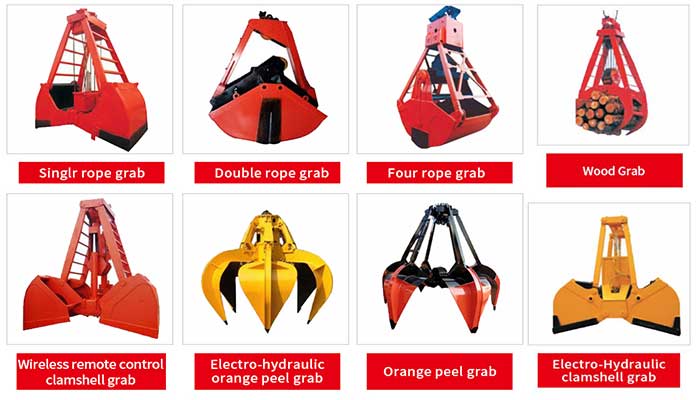
Grab Bucket Systems for Coal Mining
Types of Grab Buckets
Grab buckets are essential tools for handling bulk coal in mining operations. These buckets are designed to provide precise control and safe transport of coal, adapting to various material types and operational needs. Below are the main types of grab buckets used in coal mining:
Clamshell Grabs:
- Purpose: Clamshell grabs are widely used for handling large, bulk coal loads. They are ideal for operations requiring high capacity and control.
- Design Features: With two interlocking jaws, clamshell grabs can scoop up significant amounts of coal in one operation. The buckets close securely, ensuring that coal is transported without spilling.
- Advantages: High lifting capacity and good control, making them suitable for large-scale mining operations.
Single-Rope Grabs:
- Purpose: Single-rope grabs are designed for lighter, more precise handling of coal. They are often used in smaller operations or areas that require more careful control of material movement.
- Design Features: These grabs are simpler and lighter than clamshell grabs, using a single rope to open and close the bucket.
- Advantages: More precise control, ideal for smaller operations or where only moderate quantities of coal need to be handled at a time.
Double-Rope Grabs:
- Purpose: Double-rope grabs are used for handling heavier loads, making them perfect for large coal handling operations where stability and control are essential.
- Design Features: These grabs utilize two ropes to open and close the bucket, offering greater stability compared to single-rope models.
- Advantages: Enhanced control and stability, capable of handling heavier loads and larger quantities of coal or ore.
Custom Grab Buckets:
- Purpose: Custom grab buckets are designed to meet specific operational requirements. These buckets are tailored for particular materials, such as coal, minerals, or waste, ensuring maximum efficiency and safety during handling.
- Design Features: Custom designs can include unique shapes, sizes, and materials based on the specific needs of a mining operation.
- Advantages: Tailored to meet the exact demands of the operation, offering greater efficiency and minimizing material handling risks.
Capacity and Load Handling
Typical Load Capacities: Grab buckets come in a variety of sizes to match the specific needs of coal mining operations. The typical load capacities for grab buckets used in the mining industry range from 5 tons to 50 tons, depending on the scale of the operation and the equipment's design. These capacities can vary based on:
- Small-scale Operations: Typically use grab buckets with a capacity of around 5 tons to 10 tons.
- Medium-scale Operations: May require grab buckets ranging from 10 tons to 25 tons.
- Large-scale Operations: Larger, more robust grab buckets, often with capacities ranging from 30 tons to 50 tons, are used to handle bulk coal efficiently.
Handling Coal in Various Forms: Different forms of coal—lump, powder, and slurry—require specific handling techniques, and grab buckets are designed to optimize performance for each type:
- Lump Coal: Larger, more solid pieces of coal that are easier to handle and scoop up with grab buckets. Clamshell grabs are often used for this type due to their high lifting capacity.
- Powdered Coal: Fine coal dust is more challenging to handle because of its small particles. Custom grab buckets can be designed with special seals to prevent dust from escaping, ensuring both safety and efficiency in loading and unloading.
- Coal Slurry: A mixture of coal and water often requires specialized grab buckets with reinforced sealing and drainage systems to handle the liquid content along with the solid coal.
Variable Bucket Sizes: Crane systems can be customized with different grab bucket sizes to match the operational demands of the mine. This flexibility allows mining operations to handle everything from small batches of coal to massive bulk loads with ease. Adjustments to bucket sizes can include:
- Smaller Buckets: Used in confined spaces or smaller mining operations where only limited quantities need to be handled.
- Larger Buckets: Suitable for larger coal mines or bulk loading and unloading areas, capable of moving large amounts of material at once.
Custom grab bucket sizes help optimize efficiency in coal handling and ensure that each operation has the right tool for the job. This ability to tailor bucket sizes to specific operational needs ensures that coal is transported quickly and safely, minimizing downtime and improving productivity.
Applications of Explosion-Proof Gantry Cranes with Grab Buckets
Material Handling in Open-Pit Coal Mines
Loading and Unloading Coal: Explosion-proof gantry cranes with grab buckets are widely used in open-pit coal mines to transfer coal from mining trucks to conveyors or storage bins. These cranes eliminate the need for manual labor, reducing the risk of sparks and dust dispersion.
- Reduces manual labor and enhances safety
- Minimizes risk of spark ignition
- Controls dust dispersion in hazardous environments
Efficient Coal Movement: These cranes help improve operational efficiency by moving bulk coal quickly and precisely. They ensure that coal is transferred with minimal waste or spillage, optimizing the mining process.
- Speeds up coal movement
- Minimizes spillage and waste
- Increases overall efficiency in coal handling
Underground Coal Mining Applications
Confined Space Operations: Explosion-proof gantry cranes are essential for underground coal mining, where space is limited. Their compact design allows them to operate safely in confined spaces, with explosion-proof features to mitigate hazards like combustible gases and dust.
- Compact and maneuverable in confined spaces
- Explosion-proof features for safety
- Perfect for high-risk underground environments
Loading and Transportation: These cranes are used to load and transport coal from mining tunnels to the surface. They help move coal to conveyors or elevators, ensuring the safe and efficient transport of coal in hazardous underground environments.
- Facilitates coal transport to the surface
- Ensures safe handling in hazardous environments
- Improves coal transportation efficiency
Coal Preparation Plants
Bulk Handling from Railcars or Trucks: In coal preparation plants, explosion-proof gantry cranes equipped with grab buckets unload bulk coal from railcars or trucks. This helps move coal quickly to the processing area, ensuring safe and efficient material handling.
- Essential for moving coal from railcars/trucks
- Ensures safe handling in high-risk areas
- Improves processing line efficiency
Integration into Processing Lines: The cranes integrate seamlessly into various stages of the coal preparation process, including screening, washing, and blending. Grab buckets offer precise control to ensure efficient coal handling throughout the plant.
- Integrates into coal processing lines
- Ensures efficient handling of coal
- Provides precise control during coal processing
Typical Capacities of Explosion-Proof Gantry Cranes with Grab Buckets in Mining Applications
The capacity of explosion-proof gantry cranes with grab buckets can vary based on the specific application, material being handled, and operational requirements. However, the following are typical ranges for mining industry applications:
Small to Medium Capacity (1 to 10 tons)
- Applications:Smaller cranes in this range are typically used in confined spaces (such as underground mines) or for handling smaller loads of coal, ores, or minerals.These cranes are commonly used in processing plants or for handling less demanding material transport tasks.
- Capacity Examples:1-ton, 2-ton, 5-ton cranes with grab buckets.
Medium to Large Capacity (10 to 50 tons)
- Applications:These cranes are used in larger mining operations, including open-pit coal mines, and at surface material handling locations like bulk loading/unloading stations, ore processing, and storage facilities.They handle larger volumes of coal or minerals and are often integrated with larger conveyors or transport systems.
- Capacity Examples:10-ton, 20-ton, 30-ton, and 50-ton cranes with grab buckets.
Heavy-Duty Capacity (50 tons and above)
- Applications:Heavy-duty cranes with grab buckets are used in the largest mining operations, such as major coal mining sites or large-scale ore processing plants, where the demand for high-capacity material handling is critical.These cranes are often used for bulk handling of materials and large-scale storage operations.
- Capacity Examples:75-ton, 100-ton, and even 150-ton cranes with grab buckets.
Explosion-proof grab bucket gantry cranes are essential for ensuring safe and efficient material handling in mining industries, particularly where explosive gases, dust, or vapors are a concern. The cranes' capacities range from smaller models (1 ton to 10 tons) for confined or specialized tasks, to large cranes (up to 100 tons or more) for handling bulk materials in large-scale mining operations. Their explosion-proof design ensures that operations can proceed without the risk of sparks or ignition, which is crucial in environments with combustible materials like coal.
Benefits of Explosion-Proof Gantry Cranes with Grab Buckets
Enhanced Safety and Risk Mitigation
Explosion Prevention: Explosion-proof gantry cranes are designed to eliminate common ignition sources such as sparks, hot surfaces, and friction. These safety features significantly reduce the risk of dangerous explosions, which is crucial in the coal mining environment where flammable gases, dust, and other hazardous materials are prevalent.
- Eliminates sparks, friction, and hot surfaces
- Reduces the risk of explosions in hazardous environments
- Protects workers and equipment from ignition hazards
Regulatory Compliance: Explosion-proof gantry cranes meet rigorous safety standards, such as ATEX and IECEx, ensuring compliance with regulations for operations in explosive atmospheres. This compliance helps maintain long-term operational stability while avoiding costly fines or shutdowns due to safety violations.
- Meets international safety standards (e.g., ATEX, IECEx)
- Ensures compliance with strict mining regulations
- Reduces risk of costly safety violations and operational downtime
Increased Efficiency in Material Handling
Faster Loading and Unloading: Automation in explosion-proof gantry cranes enhances the speed and accuracy of loading and unloading tasks. These cranes help reduce operational times, allowing for quicker transfers of coal from mining trucks to conveyors or storage, thus improving overall productivity.
- Speeds up loading and unloading processes
- Increases the accuracy of material handling
- Reduces overall operational time, boosting productivity
Higher Material Throughput: Explosion-proof gantry cranes are capable of handling large volumes of coal, which leads to a higher throughput rate in mining and processing operations. This ability to manage bulk material efficiently makes them ideal for high-demand environments where time and throughput are critical.
- Handles large coal volumes efficiently
- Boosts productivity in mining and processing operations
- Ensures smooth material flow in high-demand environments
Cost-Effectiveness
Reduced Labor Costs: By automating material handling processes, explosion-proof gantry cranes reduce the need for manual labor. This not only lowers labor costs but also reduces the potential for human error, improving both safety and operational efficiency.
- Decreases reliance on manual labor
- Lowers labor costs through automation
- Reduces human error and improves safety
Low Maintenance Needs: Explosion-proof gantry cranes are designed with robust, sealed, and protected components, which minimizes wear and tear. This design results in lower maintenance needs compared to traditional cranes, reducing downtime and long-term maintenance costs.
- Robust, sealed design reduces wear and tear
- Low maintenance requirements, saving time and money
- Extends the lifespan of equipment with fewer repairs
Design and Customization Options
Design Features for Coal Mining Environments
Custom Crane Sizes and Lifting Heights: Explosion-proof gantry cranes can be customized to meet the specific needs of a coal mine. Cranes can be tailored to different lifting heights, load capacities, and configurations, ensuring that each mine site has equipment that suits its unique operational requirements. Whether for underground or open-pit mining, cranes can be designed to fit tight spaces or reach extended heights to move large coal loads.
- Tailored lifting heights and capacities for various mining operations
- Custom configurations to suit specific mine site layouts
- Ideal for both confined spaces and large, open-pit operations
Anti-Corrosion Coatings: Mining environments, particularly those exposed to dust, moisture, and chemicals, can cause significant wear on equipment. To counter this, explosion-proof gantry cranes are equipped with anti-corrosion coatings that protect against rust and other forms of deterioration. These coatings are crucial for ensuring the longevity and performance of cranes in harsh conditions, minimizing downtime for maintenance and replacement.
- Protects cranes from corrosion caused by dust, humidity, and chemicals
- Extends crane lifespan, reducing maintenance needs
- Essential for maintaining crane integrity in extreme mining environments
Customization for Grab Buckets
Bucket Size and Shape: Grab buckets can be designed to match the specific coal types being handled, from lump coal to fine powder. Custom bucket sizes and shapes allow for optimized handling of coal, ensuring maximum efficiency and minimal waste during loading and unloading operations. This customization ensures that the right bucket is used for the right task, improving both the speed and safety of material handling.
- Custom bucket designs for different coal types (lump, powder, slurry)
- Optimized shapes for efficient loading and unloading
- Reduces material spillage and enhances coal handling precision
Heavy-Duty Components: For larger mining operations, cranes with heavy-duty components are required to handle larger volumes of coal without compromising on safety or efficiency. These components include reinforced structural elements and higher capacity grab buckets, which ensure that the crane can perform consistently even under the strain of high-load operations. These heavy-duty features are designed to meet the demands of large-scale coal mining.
- Heavy-duty structural components for higher load capacities
- Reinforced grab buckets for larger volumes of coal
- Ensures efficient operation without sacrificing safety or performance
Case Studies and Success Stories
Case Study 1: Open-Pit Coal Mining Operations
Overview: In a major open-pit coal mine, the implementation of an explosion-proof gantry crane equipped with a grab bucket system significantly enhanced both safety and operational efficiency.
- Safety Improvements: The crane's explosion-proof design eliminated common ignition sources, such as sparks and hot surfaces, reducing the risk of fires or explosions. This was particularly important in an open-pit mine, where dust and gas accumulations are common.
- Increased Efficiency: The crane enabled faster loading and unloading of coal, reducing the time spent on manual labor and increasing overall throughput. The grab bucket system allowed precise handling of bulk material, preventing spillage and loss.
- Regulatory Compliance: The crane helped the mine adhere to strict safety standards, such as ATEX and IECEx, ensuring that the operation met all required regulatory guidelines for handling explosive materials.
Case Study 2: Underground Mining Application
Overview: In an underground coal mine, an explosion-proof gantry crane with a grab bucket system was deployed to handle coal in confined spaces, where traditional cranes would not meet safety requirements.
- Space Efficiency: The compact design of the explosion-proof crane made it possible to navigate tight underground tunnels, where larger equipment would be impractical or too dangerous.
- Safety in High-Risk Areas: With explosion-proof features, the crane ensured safe operation in environments with elevated gas concentrations and dust, which would typically pose a serious ignition risk for standard equipment.
- Operational Success: The crane enabled the efficient transfer of coal from deep within the mine to the surface. The grab bucket system allowed for precise control over the material, reducing spillage and ensuring minimal disruption to other operations.
Case Study 3: Coal Preparation Plants
Overview: At a coal preparation plant, the introduction of explosion-proof gantry cranes equipped with grab buckets improved both the processing efficiency and worker safety.
- Enhanced Coal Processing: The cranes efficiently moved coal from railcars and trucks into the preparation plant. The grab bucket system ensured smooth material flow, contributing to a seamless integration into the plant's screening, washing, and sorting processes.
- Worker Safety: By automating the handling process and eliminating manual labor, the cranes reduced worker exposure to dangerous conditions, such as coal dust and the risk of accidental ignition. The explosion-proof design further protected workers from potential hazards in a volatile environment.
- Operational Benefits: The cranes improved throughput, reducing processing delays and enhancing the plant's overall productivity. This case highlights the significant role explosion-proof gantry cranes play in enhancing safety and efficiency in the coal preparation phase.
These case studies demonstrate the tangible benefits of using explosion-proof gantry cranes in various coal mining operations, from open-pit mining to underground applications and coal preparation plants. The integration of grab bucket systems has proven to be a critical factor in improving both safety and operational efficiency in these environments.
Conclusion
Explosion-proof gantry cranes with grab bucket systems are critical for enhancing safety and operational efficiency in coal mining operations. These cranes are designed to prevent ignition sources, safeguarding workers and the environment from potential explosions caused by combustible dust and gases. Their ability to handle large quantities of coal, whether in open-pit mines or underground, improves material handling, reduces manual labor, and boosts overall productivity. The combination of explosion-proof features and precision handling ensures that coal mining operations comply with stringent safety standards while optimizing throughput and reducing risks.
Innovations in Grab Bucket Designs
The design of grab buckets is also expected to evolve, offering better solutions for coal handling:
- Enhanced Materials Handling: Future grab bucket designs will be optimized to handle a broader range of materials, including various coal types, ore, and waste products. These improvements will help improve the efficiency of material transfer and prevent spillage.
- Improved Performance in Harsh Environments: New materials and coatings will be developed to extend the life of grab buckets, ensuring they perform well even in the harshest mining conditions. This will reduce maintenance needs and improve overall operational efficiency.
In conclusion, explosion-proof gantry cranes with grab buckets will continue to play a pivotal role in transforming the coal mining industry, making operations safer, more efficient, and more cost-effective. With upcoming advancements in automation, safety, and bucket designs, these cranes will remain at the forefront of innovation in mining equipment.
FAQs
How does explosion-proof certification affect crane performance?
Explosion-proof certification ensures that cranes meet safety standards for operating in hazardous environments, such as coal mines where combustible dust or gases are present. This certification involves designing cranes to prevent ignition sources like sparks, hot surfaces, or friction. While meeting these standards may involve using more specialized materials and construction techniques, it does not compromise crane performance. In fact, explosion-proof cranes are designed to operate safely and efficiently under extreme conditions. Features such as flameproof enclosures, anti-static components, and sealed electrical systems are integrated to maintain full performance while minimizing the risk of ignition. Ultimately, this certification enhances operational safety without affecting the crane's ability to handle heavy loads or perform tasks at optimal speed.
What maintenance practices should be followed for explosion-proof gantry cranes?
To ensure the long-term reliability and safety of explosion-proof gantry cranes, regular maintenance is essential. Recommended maintenance practices include:
- Inspection of Electrical Components: Check all electrical systems, including motors, cables, and connectors, for signs of wear, corrosion, or damage. Electrical components should be inspected regularly to ensure they remain sealed and free from any dust or moisture ingress.
- Structural Integrity Checks: Regularly examine the crane's frame, beams, and lifting components for any cracks, deformations, or wear. The structure should be robust and intact to maintain safe operation under heavy loads.
- Explosion-Proof Features: Inspect the flameproof enclosures, explosion vents, and seals to ensure they are intact and functioning as intended. These components are crucial in preventing ignition in hazardous environments and should be checked for any signs of damage or malfunction.
- Lubrication and Cleaning: Ensure that all moving parts, including motors, gears, and joints, are properly lubricated. Cleaning is also essential to remove dust and debris, which can interfere with the crane's operation or increase the risk of sparks.
- Grounding Systems: Verify that grounding systems are effective and functioning properly to prevent the buildup of static electricity. Proper grounding ensures that the crane operates safely in environments with a high risk of static discharge.
By adhering to these maintenance practices, the crane will continue to perform safely and efficiently, extending its lifespan and preventing costly breakdowns in hazardous mining conditions.
Main Projects
Related Products
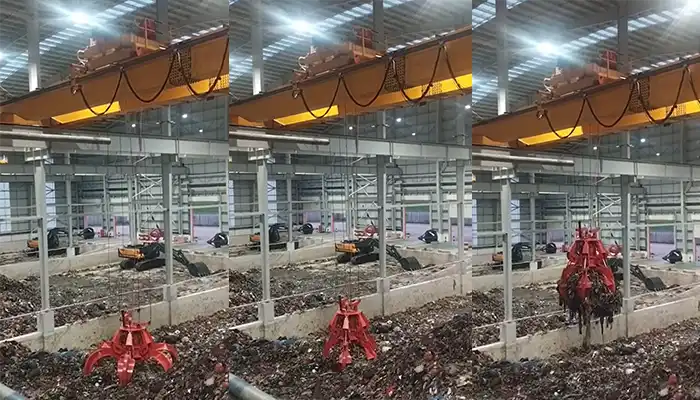
Supplied three grab bucket crane kits to Indonesia, enhancing garbage handling efficiency with high load capacity and reliable performance.
Free consultation to Confirm Parameters & Specifications and Get
Latest Crane Price & Crane Rate.
- Types of overhead cranes : _______?
- Optional: Overhead travelling crane, goliath gantry crane,Slewing jib crane, Single girder or double girder crane,small portable crane or kbk crane, etc.
- Capacity of overhead crane: _______?
- Optional: 0.25ton, 0.5 ton, 1 ton, 2 ton, 3ton, 5 ton, 10 ton,15ton, 20ton, 25 ton, 30ton,35ton, up to 550ton, etc.
- Crane span & lifting height : _______?
- Crane travelling length : _____?
- Control of overhead crane:_______?
- Optional: pendant/ remote/cabin control
- Voltage supply of overhead crane:_____?
- Eg,: 380V50/60HZ,3Phase or others,etc.
- Application/usage of crane:_______?
- Eg,: Steel mill, ,injection mold, cement,stone, concrete,granite, general manufacturing, etc.
Just leave a message via the contact form and our hoist and crane engineer will contact you with in 24working hours.
Get In Touch
